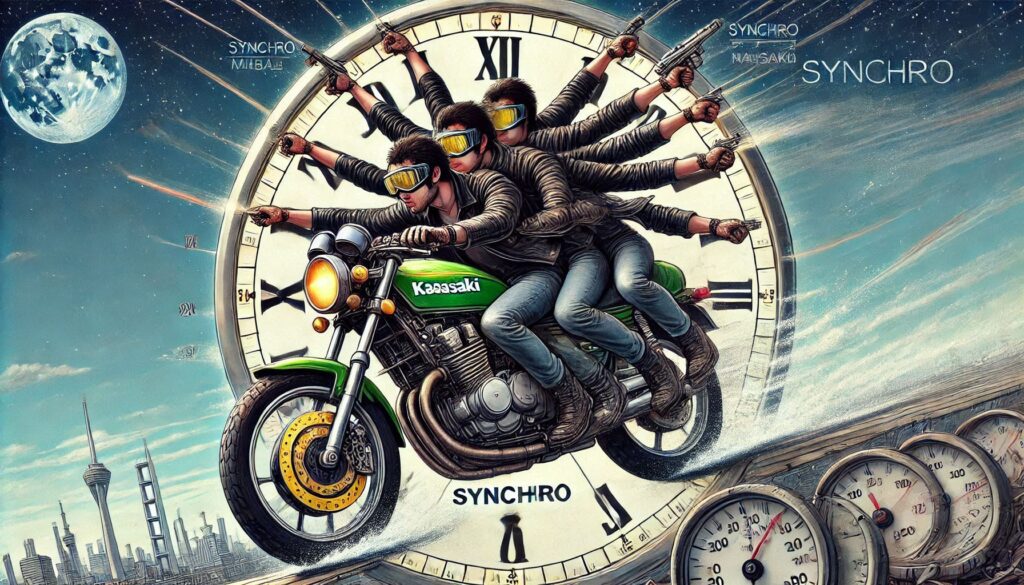An essential maintenance procedure that has a direct impact on engine longevity and performance is synchronising a motorcycle’s carburettors or throttle bodies. This procedure is crucial for Kawasaki motorcycles, especially those like the GPZ 900, 750, and 600 R. This process, called “Synchro Mbar Kawasaki,” guarantees that every cylinder runs simultaneously, producing a balanced air-fuel combination. This article explores the significance of throttle body synchronisation, the necessary equipment, and detailed instructions for carrying out this work successfully.
Why Synchronization Matters
In a multi-cylinder engine, synchronisation, also known as balancing the throttle bodies or carburettors, guarantees that each cylinder receives an equal amount of fuel and air. The engine may display symptoms including rough idling, inconsistent power delivery, higher fuel consumption, and excessive vibrations if it is not properly synchronised. Sustaining synchronisation is essential for Kawasaki bikes in order to get the best throttle response, seamless acceleration, and overall engine economy.
Tools Required for Synchro Mbar Kawasaki
It takes a few specific tools to conduct synchronisation on Kawasaki bikes. A throttle body synchroniser, which usually consists of many digital sensors or vacuum gauges, is one of the most crucial instruments. By using these gauges to monitor the vacuum pressure in each cylinder, you may modify the carburettors or throttle bodies as necessary. Other tools include:
- Screwdrivers: To adjust the synchronization screws.
- Wrenches: For loosening and tightening necessary components.
- Service Manual: Provides specific details for your Kawasaki model.
Steps for Throttle Body Synchronization
1. Preparation
Make sure the motorbike is on a firm surface and the engine is running at room temperature before beginning the synchronisation procedure. To get reliable readings, this is essential.
- Step 1: Turn off the engine and remove any necessary components to access the throttle bodies or carburetors.
- Step 2: Connect the synchronizer tool to each throttle body or carburetor using the vacuum ports.
2. Initial Setup
Start the engine and let it idle. Observe the readings on the synchronizer tool.
- Step 3: Adjust the idle speed to the manufacturer’s specifications using the idle adjustment screw.
- Step 4: Note the vacuum readings for each cylinder.
3. Synchronization Process
The goal is to equalize the vacuum pressure across all cylinders.
- Step 5: Identify the cylinder with the highest vacuum reading.
- Step 6: Adjust the synchronization screws on the other cylinders to match the highest reading.
- Step 7: Make small adjustments and allow the engine to stabilize before proceeding to the next cylinder.
4. Final Adjustments
After balancing all cylinders, recheck the readings to ensure stability.
- Step 8: If necessary, repeat the adjustments until all cylinders have equal vacuum readings.
- Step 9: Tighten all screws and reassemble any components that were removed.
Also Read: https://everscroll.org/category/technology/
Common Issues and Troubleshooting
Even with careful adjustments, some issues may arise during synchronization. Here are a few common problems and solutions:
- Fluctuating Vacuum Readings: This could indicate a leak in the vacuum lines or a faulty synchronizer tool. Inspect and replace any damaged components.
- High Idle Speed: Ensure the idle adjustment screw is set correctly and that there are no air leaks.
- Uneven Power Delivery: Double-check the synchronization and look for any other mechanical issues such as valve clearance or spark plug condition.
Benefits of Proper Synchronization
Proper synchronization of the throttle bodies or carburetors offers numerous benefits:
- Improved Throttle Response: Balanced cylinders ensure smooth and responsive throttle input.
- Better Fuel Efficiency: An equal air-fuel mixture reduces unnecessary fuel consumption.
- Reduced Engine Vibrations: Synchronization minimizes engine vibrations, leading to a more comfortable ride.
- Enhanced Engine Longevity: Regular synchronization prevents undue stress on engine components, prolonging the life of the engine.
When to Perform Synchronization
It’s recommended to perform synchronization:
- Regularly: As per the intervals suggested in the motorcycle’s service manual.
- After Major Engine Work: Such as replacing throttle bodies, carburetors, or adjusting valve clearances.
- When Noticing Symptoms: Such as rough idling, increased fuel consumption, or uneven acceleration.
Conclusion
Synchro Mbar Kawasaki, or synchronising the throttle bodies or carburettors of Kawasaki bikes, is an essential maintenance procedure that guarantees the best possible engine performance and efficiency. Riders can keep their bikes in excellent condition and enjoy a smoother, more pleasurable ride by using the correct equipment and techniques. For any Kawasaki motorcycle owner, regular synchronisation is a must as it not only improves performance but also extends the engine’s lifespan.
FAQs
1. What is Synchro Mbar Kawasaki?
Synchro Mbar Kawasaki refers to the synchronization of throttle bodies or carburetors on Kawasaki motorcycle to ensure balanced air-fuel mixtures across all cylinders.
2. Why is synchronization important for Kawasaki motorcycles?
Proper synchronization improves throttle response, fuel efficiency, reduces engine vibrations, and enhances overall engine performance.
3. How often should I synchronize my Kawasaki motorcycle’s throttle bodies?
Refer to your motorcycle’s service manual for specific intervals, but it’s typically recommended to synchronize after major engine work or when noticing performance issues.
4. Can I synchronize the throttle bodies myself?
Yes, with the right tools and knowledge, you can perform synchronization yourself. However, if you’re inexperienced, it’s advisable to seek assistance from a qualified technician.
5. What tools are needed for Synchro Mbar Kawasaki?
You will need a throttle body synchronizer, screwdrivers, wrenches, and a service manual specific to your Kawasaki model.

